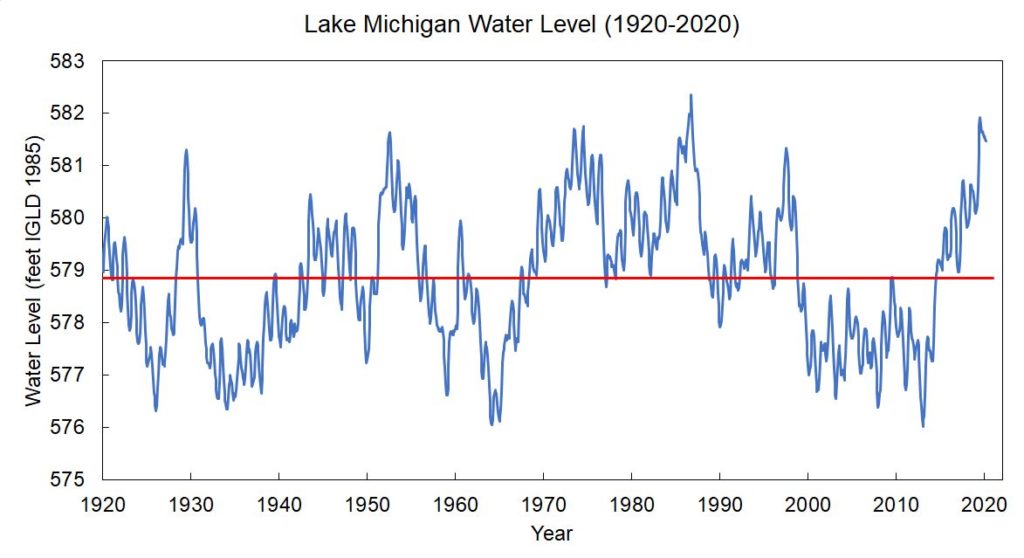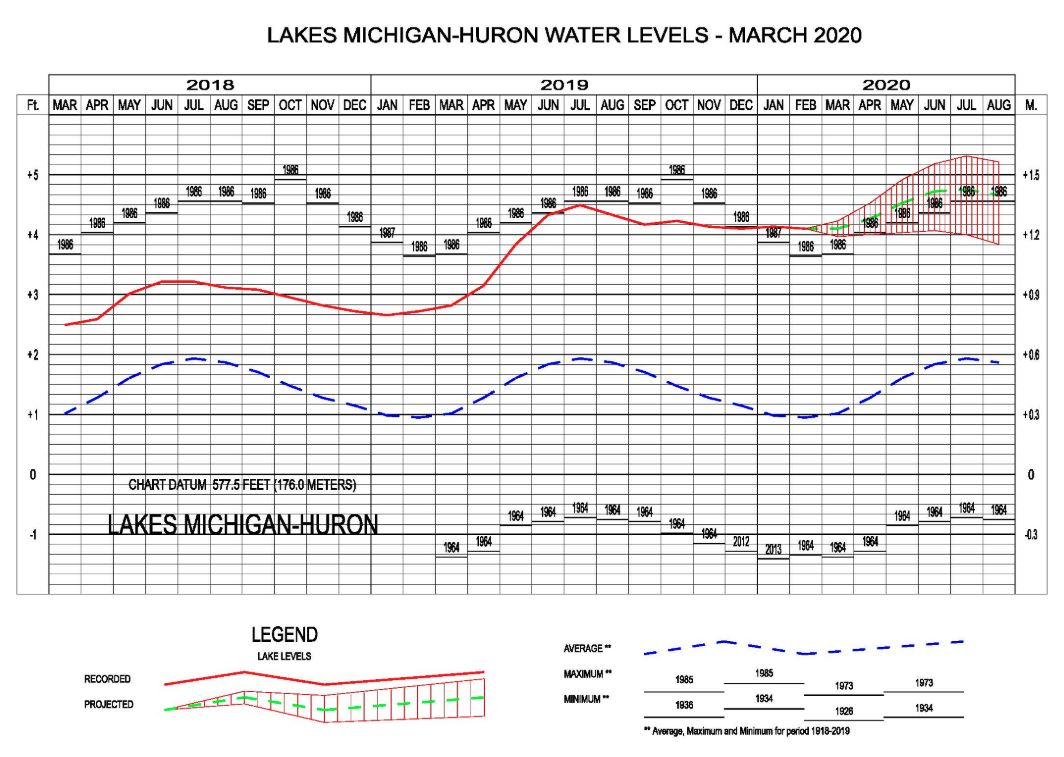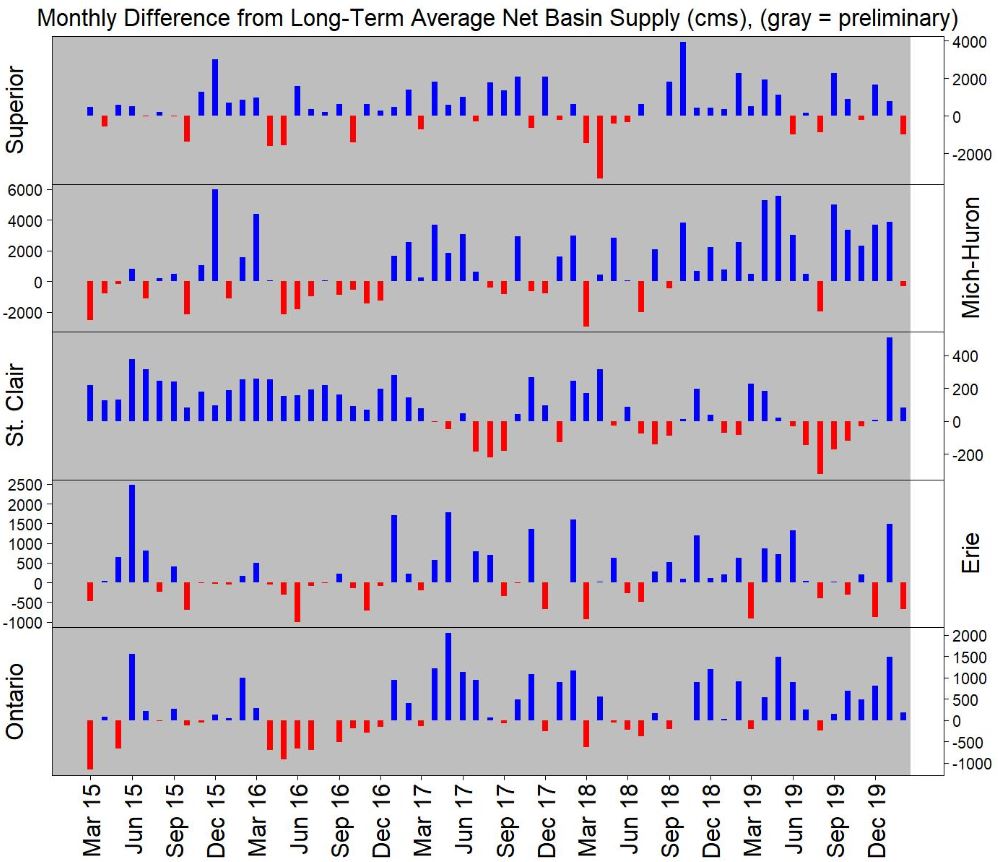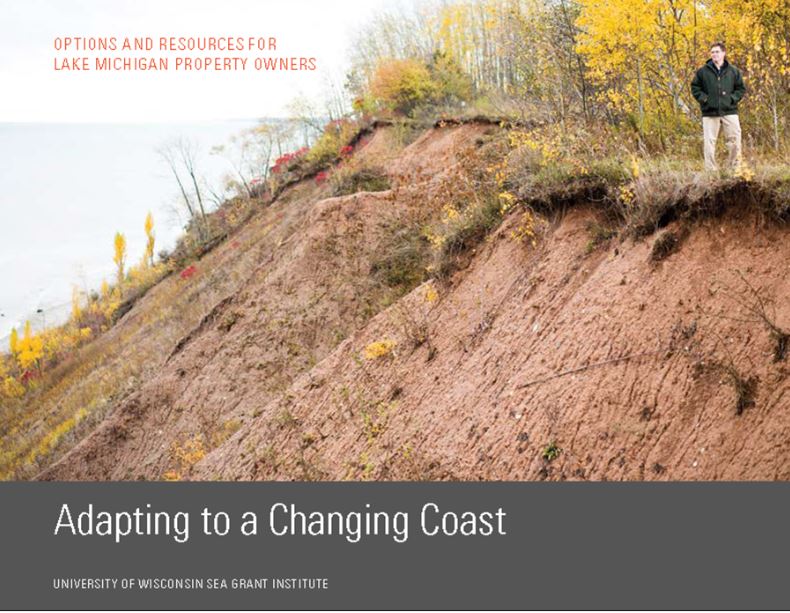
March 19, 2020
By Lydia Salus, Coastal Resilience Project Assistant, Wisconsin Sea Grant
The water levels on all the Great Lakes still remain above their long-term monthly averages as of the beginning of March 2020. Lake Michigan surpassed its record-high monthly mean for February previously set in 1986. This is the second monthly record set for Lake Michigan in our recent period of high water levels. Lake Michigan water levels decreased by about an inch from January to February. Lake Michigan is expected to resume its seasonal rise over the next two months.
Here are five things to know about water levels on Lake Michigan for March 2020.
What are the current water levels on Lake Michigan?
The water level of Lake Michigan as of March 13, 2020 is at an elevation of 581.46 feet above sea level (from the International Great Lakes Datum). To put this level into perspective, here are some statistics for Lake Michigan relative to the period of water level records measured from 1918 to 2018: (statistics from USACE’s Weekly Water Level Update and USACE’s Water Level Summary).
| Compared to… | Current Water Levels are… |
| One month ago | 1 inch lower |
| One year ago | 15 inches higher |
| Long-term March monthly average (1918 to 2019) |
37 inches higher |
| Record March monthly mean (set in 1986) | 4 inches higher |
What is the outlook for future water levels?
The US Army Corps of Engineers (USACE) projects higher than average and potentially record high water levels to persist for at least the next six months (see six-month forecast issued for March 2020 below).
While water levels on Lake Michigan decreased by about an inch over the last month, the USACE is projecting that water levels will resume their seasonal rise and increase by ~2 inches by April 13, 2020. An increase in water levels generally occurs throughout the spring as precipitation and snowmelt typically increase. In an average year, water levels vary seasonally by about one foot from a peak in summer to a low in winter, though every year is different.

Six month water level forecast for Lake Michigan issued March 2020. Source: U.S. Army Corps of Engineers – https://www.lre.usace.army.mil/Missions/Great-Lakes-Information/Great-Lakes-Water-Levels/Water-Level-Forecast/Monthly-Bulletin-of-Great-Lakes-Water-Levels
Why are lake levels still high?
The story of Great Lakes water level changes is told by Net Basin Supply. Net Basin Supply accounts for water going into a lake in the form of precipitation and runoff minus water leaving a lake due to evaporation of water from the lake surface. In general, when Net Basin Supply is positive, more water enters the lake than leaves, causing a rise in lake levels. Over the last five years, Net Basin Supply has been consistently positive, driving all the Great Lakes to rise.
Despite below average precipitation and above average evaporation in February, runoff to the Lake was about average. However, Lake Michigan’s Net Basin Supply was ultimately negative (see image below) for February causing that slight decrease in water levels that we saw. However, the water levels are expected to rise through March and April after Lake Michigan saw a less than average seasonal decline in water levels over the winter.

This graphic shows the long term average NBS for the past 5 years. Source: U.S. Army Corps of Engineers – https://www.lre.usace.army.mil/Missions/Great-Lakes-Information/Great-Lakes-Information-2/Basin-Conditions/
What would make water levels go down?
The historic record shows that water levels in the Great Lakes rise and fall with changes in precipitation and evaporation, so we know our high water levels will not be around forever. But what are the perfect conditions that would help water levels go down sooner rather than later? According to Keith Kompoltowicz, chief of watershed hydrology at the USACE’s Detroit district “we don’t want a healthy snowpack. We want a warm, snowless winter followed by a warm, dry spring.” Those would be the ideal conditions – low precipitation and runoff with high evaporation – to get a below average Net Basin Supply which would draw down lake levels. This winter, Lake Michigan continued to see higher than average precipitation and below average evaporation and while February was a dry month, precipitation is expected to increase in March and April. Therefore, it is unlikely that water levels will go down in the spring of 2020.
Five places you can find more information:
 Our Coastal Hazards page for details about the impacts of high water levels, including erosion, flooding, and navigation issues.
Our Coastal Hazards page for details about the impacts of high water levels, including erosion, flooding, and navigation issues.- Our blog post Resources for Great Lakes Coastal Property Owners: Where do I start? has links to many resources to help
- understand coastal hazards
- weigh the risks coastal hazards pose to property
- understand options for addressing these hazards
- get started on implementing actions if necessary.
- The Great Lakes Water Budgets from the University of Michigan gives more information about what makes the lakes go up and down
- The US Army Corps’ Great Lakes Information page has tons of details on water levels.
- Our Resource of the Month featured here.






